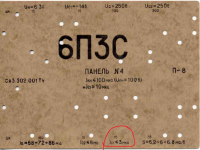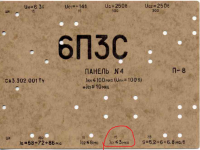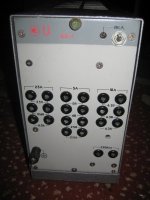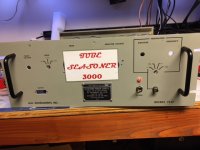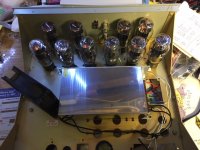Later I tested / measured several 6p3s-e and 6p3s tubes to sort pairs, quads, octet, etc. The advantage of large batches is that any tube finds the pair, even the same, with no tolerance percentages, of course, however, there is the tolerance of the tubetester, the reading error, etc. For better precision, I monitor negative Ug1 on an external measuring device because a small run of this leads to a higher run of anode current. (S is between 5 and 6 so 0.1 V deviation Ug1 leads to 0.5 / 0.6 mA deviation of the anode current).
The problem is that I gave a 6p3s box from which I have already measured about 15 tubes and all have the current of the 1 grid too big. The manufacturer gives the condition that Ig1 <= 3 microA but the tubes in this box are between 7 and 10 microA, some give the needle head speed. The remainder of the parameters - the leakage cathode filament, Ig2, Ia, S - are within normal limits. The tubetester has no problems, checks its calibrations for every 10th test tube, also after we have given the suspicious tubes, I rechecked a test tube stopped from a previous lot and look ok, that is precisely the noted parameters and Ig1 insignificant, 0.25 microA.
Before I made a SE test, does anyone know how such a tube would appear in an amp? How "defective" are the tubes? What does this over-current grid 1 mean?
The tubes are NOS / NIB 50 pieces per box, smaller batch - only 100 pieces with this date, 12/1986 fabrication, the original box, all the same date, so there is no question of the tubes being used, changed or otherwise by this genre, I do not think anyone else opened the little boxes earlier.
In the photo is the tubetester card for this type of tube.
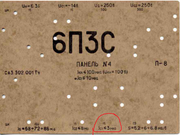
The problem is that I gave a 6p3s box from which I have already measured about 15 tubes and all have the current of the 1 grid too big. The manufacturer gives the condition that Ig1 <= 3 microA but the tubes in this box are between 7 and 10 microA, some give the needle head speed. The remainder of the parameters - the leakage cathode filament, Ig2, Ia, S - are within normal limits. The tubetester has no problems, checks its calibrations for every 10th test tube, also after we have given the suspicious tubes, I rechecked a test tube stopped from a previous lot and look ok, that is precisely the noted parameters and Ig1 insignificant, 0.25 microA.
Before I made a SE test, does anyone know how such a tube would appear in an amp? How "defective" are the tubes? What does this over-current grid 1 mean?
The tubes are NOS / NIB 50 pieces per box, smaller batch - only 100 pieces with this date, 12/1986 fabrication, the original box, all the same date, so there is no question of the tubes being used, changed or otherwise by this genre, I do not think anyone else opened the little boxes earlier.
In the photo is the tubetester card for this type of tube.

Attachments
Last edited:
Activate the getter is a job for the tube seller that should have a proper heater, few audio amps can be used to run getter as it take many hours, many tubes dont resist this process and fail.
Once I read in a builder site to heat the tube 2 hours per day for various days.
Once I read in a builder site to heat the tube 2 hours per day for various days.
Last edited:
Thank you for the answers.
They're not my tubes, I'm working with an ebay seller, I'm testing them for him. I have the stabilized source a.c. in the picture and a panel with 20 sockets, each tube is kept about 1 hour warmed up before testing. In fact, from this type of tube I only put 18 pieces, the heating current approaches the 18A limit of the power supply.
This batch of tubes is compromised for sale, the seller will not risk feedback for 50 tubes. So I'll stay for a while to play with them, I'll try several recovery methods: I bring a tube to the red for 5 minutes, one day the maximum load and other methods that will go through my mind for my curiosity.
They're not my tubes, I'm working with an ebay seller, I'm testing them for him. I have the stabilized source a.c. in the picture and a panel with 20 sockets, each tube is kept about 1 hour warmed up before testing. In fact, from this type of tube I only put 18 pieces, the heating current approaches the 18A limit of the power supply.
This batch of tubes is compromised for sale, the seller will not risk feedback for 50 tubes. So I'll stay for a while to play with them, I'll try several recovery methods: I bring a tube to the red for 5 minutes, one day the maximum load and other methods that will go through my mind for my curiosity.
Attachments
I suspect you are measuring with a L3-3? the card suggest this, but the L1-3 and L3-3 share the same cards. Just out of curiosity, they are 95% identical.
The datasheet for the 6P3S-E quotes a G1 current of smaller then .5µA so if we go from that the tubes are still within spec, the cards show 3uA max for the generic 6P3S
The maximum G1 resistance for this tube is quoted as 150K if people would follow the datasheet, i doubt there will be any problems, some grid current is normal, and these tubes are still much better then some of the new production ones.
Keeping tubes heaters on without cathode current is bad for most tubes. some types where built to withstand this, but certainly not all.
You can stabilize the cathode activity by burning in the tubes, one way to do this that i figured was to include a small indascent lamp in the cathode lead. and apply AC to a triode connected tube. you can use DC but AC is simpler
you can use about 75-100VAC bellow that some high Ri tubes wont pull enough current on the rack , you then need to look at the triode curves to figure out what lamp you need.
The datasheet for the 6P3S-E quotes a G1 current of smaller then .5µA so if we go from that the tubes are still within spec, the cards show 3uA max for the generic 6P3S
The maximum G1 resistance for this tube is quoted as 150K if people would follow the datasheet, i doubt there will be any problems, some grid current is normal, and these tubes are still much better then some of the new production ones.
Keeping tubes heaters on without cathode current is bad for most tubes. some types where built to withstand this, but certainly not all.
You can stabilize the cathode activity by burning in the tubes, one way to do this that i figured was to include a small indascent lamp in the cathode lead. and apply AC to a triode connected tube. you can use DC but AC is simpler
you can use about 75-100VAC bellow that some high Ri tubes wont pull enough current on the rack , you then need to look at the triode curves to figure out what lamp you need.
Last edited:
That will, but the tubes arent bad to begin with, if you are a reseller that sells to upscale customers, burning them in for about 100 hours would be worthwhile. Better still to keep them, their prices have tripled in the last six years or so.
Grid emissions are likely the result of some material getting on the controll grid during manufacture of the tubes, Hot cathodes are complex, there are a number of chemical and electrical interactions that come into play.
The 6P3S-E is a truely High quality tube, dont overrun them and they will last the rated 5000 Hours.
Grid emissions are likely the result of some material getting on the controll grid during manufacture of the tubes, Hot cathodes are complex, there are a number of chemical and electrical interactions that come into play.
The 6P3S-E is a truely High quality tube, dont overrun them and they will last the rated 5000 Hours.
Nope, those are 6P3S, an equivalent of the 5881.
6P3S-E tube / 6P3S-E tubes
6P3S-E / 5881 / 6L6GC tube (own box) - POWER / OUTPUT tubes - Tubes-Store.com
6P3S-E tube / 6P3S-E tubes
6P3S-E / 5881 / 6L6GC tube (own box) - POWER / OUTPUT tubes - Tubes-Store.com
Nice to know it. What are this robust version you are refering Foton or Refector?Indeed the 6P3S is excellent. I like them better than 6P3S-E. I've gotten over 10000H running them at Pd of 23+W
Last edited:
I have both L1-3 and L3-3 but lately I used more L1-3, without a special reason. They are identical, L1-3 is one of the last variants before soviets making L3-3. I'm not a seller, nor reseller, even I have many tubes in my collection. I noticed the decrease in the current of the first grid after additional heating. Of course I won't heat them 100 hours, usually I heat them one hour but with some with excessive first grid current I'll try one night heating to see which are the effects, before before I throw them away. I have more stabilized power supplies for tubes so I can make any kind of tests on tubes but being so many tubes don't worth the time. I get about 0,5USD per tested tubes so I must find methods to work whit many tubes same time, not half of hour per tubes. Average is 10 min/tube, included depacking, testing, results on PC and sorting on PC. There are still large stocks of tubes, it will not increase the high price, especially for the tubes for which there were military stocks. Prices increases at rare tubes. There are a lot of examples of tubes that have a lower price on ebay that few years ago. As an example, I declined offers of 6n3p tubes at 0.4 USD or 12J1L, 2J27L at 0.2USD.
I'll make a short movie to show you how I made tests on one 6p3s with excessive first grid current and on good one.
I'll make a short movie to show you how I made tests on one 6p3s with excessive first grid current and on good one.
Nice to know it. What are this robust version you are refering Foton or Refector?
Reflector. I've heard the Foton ones are better, never tried them personally.
Nice thanks ))Reflector. I've heard the Foton ones are better, never tried them personally.
Seems Pd is about 20W only.
This datasheet seems correct:
http://www.teslatron.pjweb.cz/obrazky-filemanager/russian-6p3s-e.pdf
Do you think the Inspire amps from Dennis Had can run this tube?
I've been playing and what I noticed:
- at a simple check with 5 minutes of heating, no tube shows current g1, it appears and increases after a minimum of 15 min of heating on the tubetester;
- I kept 10 tubes overnight to heat (only the filament fed) and then, next day, the g1 current disappears forever;
- the current does not influence the other parameters, like Ia, Ig2, S, cathode filament leakage, after overnight heating I have re-verified these parameters and are the same.
In conclusion, the tubes are good, probably put into an amp, they come back alone after a few hours of operation, possibly even without observation.
- at a simple check with 5 minutes of heating, no tube shows current g1, it appears and increases after a minimum of 15 min of heating on the tubetester;
- I kept 10 tubes overnight to heat (only the filament fed) and then, next day, the g1 current disappears forever;
- the current does not influence the other parameters, like Ia, Ig2, S, cathode filament leakage, after overnight heating I have re-verified these parameters and are the same.
In conclusion, the tubes are good, probably put into an amp, they come back alone after a few hours of operation, possibly even without observation.
I've been playing and what I noticed:
- at a simple check with 5 minutes of heating, no tube shows current g1, it appears and increases after a minimum of 15 min of heating on the tubetester;
- I kept 10 tubes overnight to heat (only the filament fed) and then, next day, the g1 current disappears forever;
- the current does not influence the other parameters, like Ia, Ig2, S, cathode filament leakage, after overnight heating I have re-verified these parameters and are the same.
In conclusion, the tubes are good, probably put into an amp, they come back alone after a few hours of operation, possibly even without observation.
You need one of these. Simply uses an smps to "season" tubes that have been in storage a long time. Ralph (Atma-Sphere) recommends 70+ hours before using. I go about 80. He believes it "cures" the cathodes. I tie all leftover
socket connections to one side of the heater as per his advice. It really makes a difference. Putting uncured power tubes in an OTL (at least in my case) is a no-no. Don't ask me how I know
Attachments
Heating gently in an owen ( 100 degrees Celcius ) for a few hours is whet is needed to
help the getter absorb remaining gas.
Using heaters only will risk introducing "sleeping sickness" which is permanent and fatal.
- Status
- This old topic is closed. If you want to reopen this topic, contact a moderator using the "Report Post" button.
- Home
- Amplifiers
- Tubes / Valves
- New Tubes with Problems?
